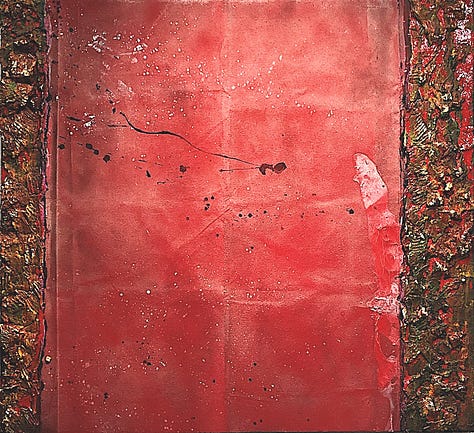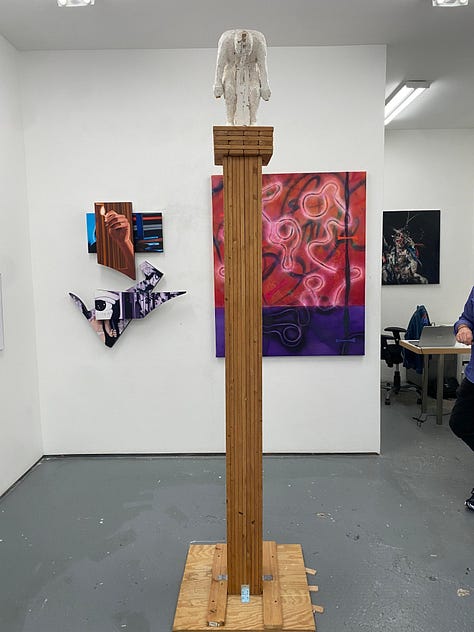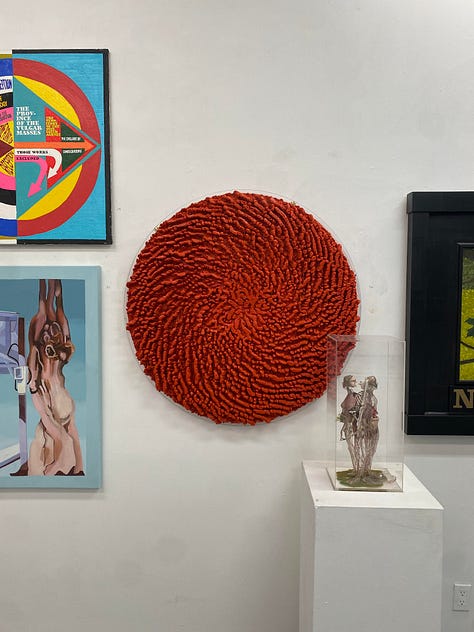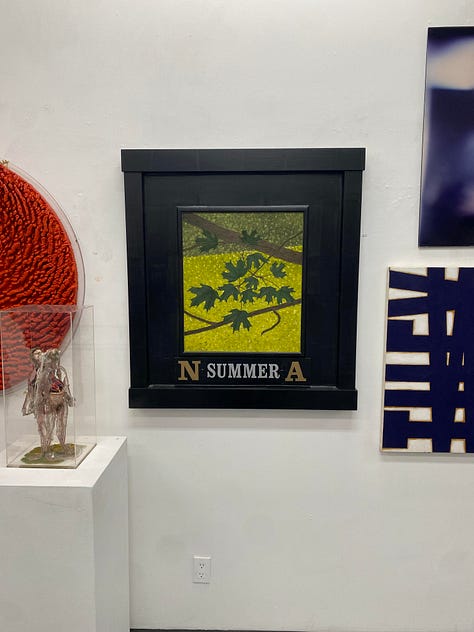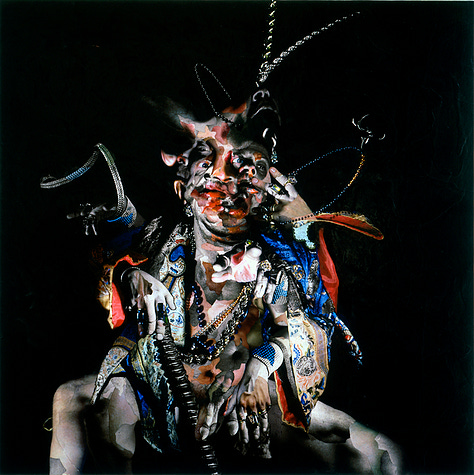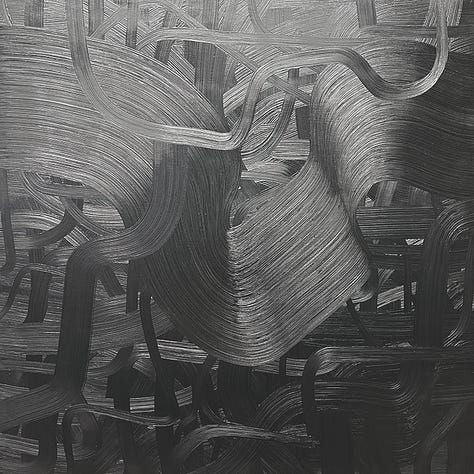Lichtundfire "In It For The Long Haul" Exhibition Review
Lictundfire recently presented “In It For The Long Haul” an exhibition featuring a multitude of different artists curated by the renowned Robert Curcio of curcioprojects. I initially was at a cafe with a friend after a long day of seeing different galleries in the Lower East Side, when after his departure, I decided to step into the gallery to close out the day. I was promptly met by Robert and asked a question about a James Murray piece Cosmic Dancer because of its similarity to a Pierre Soulage piece I saw a few weeks prior.
Robert had explained that the artist only works with black ivory paint but uses it to create different universes through a variety of different sized brushes and brushstrokes. The shine of the black paint across the canvas allowed the viewer to envision a world outside of our own where everything is the same yet has layers of different brushstrokes that tell different stories. We then moved to other pieces within the exhibition I had questions about as you could tell that each piece was carefully curated by Robert and was personal to him in some way shape or form. I immediately became entranced by this piece (arguably my favorite) that was tucked away in the back of the gallery behind Robert’s desk, TAN FUR MICH SALOME by an artist of the name Chambliss Giobbi. The eerie and almost scarily collaged image sealed with beeswax, is a series of self portraits of the artist dressed up as King Herod from the biblical story of Salome retold by Oscar Wilde in the form of a play. The compiled image is in reference to a particular scene where Salome is asked to dance for King Herod (known more specifically as The Dance of the Seven Veils) to fulfill any wish she desires. Upon viewing the piece I felt a very crude, violent, and virulent energy surrounding it almost as if I was witnessing the internal power struggle King Herod was fighting within himself. The self portrait(s) captures the perfect energy of King Herod who kept Salome captured in his palace and eventually killed Salome because he disagreed with one of her wishes. The other piece that stood out to me was a bright red piece titled Faux Material by an artist of the name Augustus Goertz. This piece stood out to me primarily due to its unique textural quality and composition. The canvas was painted in an almost faded red/pinkish tone with creases as if the canvas had been folded and then stretched back out. Robert mentioned to me how the piece uses elements of the uncertainty principle, which suggests the creation of a tactile reality while simultaneously creating something illusory. This is seen when analyzing the piece in terms of its funky textures in multiple areas of the canvas. The sides of the piece have a thick impasto on the sides that represent the more palpable reality of the piece while the bright red middle portion has a more illusory effect due to the creases that were meticulously painted by the artist to look as if the canvas had been folded and then stretched onto the canvas.
I felt drawn to other artists in the exhibition like LeRone Wilson, Edward Giordano, and Neil Jenny who all aided in expressing the rawness and unique individuality of the exhibition. LeRone Wilson’s piece Realgar RU the SPDT took a more minimalistic approach and presentation but more specifically through thorough use of color, three dimensional textured brush strokes, and the hypnotic spiral formations created, it truly allows you to imagine a world that is beyond temporality and leaves a lasting imprint on the viewer. Edward Giordano’s Ecce Homo uses the existing story of Jesus’ torture by Pontius Pilate by creating a visually striking yet raw eight foot wooden sculpture. Ecce Homo is a stark contrast to how Jesus’ story is usually portrayed in a religious setting with the use of bright colors, dramatic facial expressions, and large descriptors. Giordano’s raw and simplistic portrayal of Jesus as an anonymous figure held up on a high wooden pedestal indicates his level of importance and power within his suffering while also pointing to the idea that our suffering as humans tends to be elevated and shown to the world. I felt as if the piece gave viewers the opportunity to reinterpret how they traditionally view & experience suffering. To take away the details of a story that involves so much violence and an adherence to a specific time period in which it takes place, the sufferer high above the audience gives the viewer a feeling of isolation and uncertainty as they imagine that it could possibly be themselves high on that pedestal experiencing a personal suffering of their own.
Another artist who does this effortlessly is Neil Jenny in his piece North American Summer. I initially looked past this piece until I asked Robert what his favorite piece in the exhibit was. Robert explained to me that he had been following Jenny’s work for almost the entire span of his career as a curator. The work was simple yet complex in its presentation with a bold black frame surrounding the canvas. The frame acts as a sculpture on its own while also aiding in helping the viewer focus more intensely on the piece. The piece focuses on the shifting foliage present during the summer time littered with shadows creating a distinct line or border present in the grass. This made me heavily question what this meant. Did the line represent a shift in the season ending? Is it a simple visual depicting the changing of sunlight in the summer throughout the day? After parsing through many different answers, I felt as if it represented the quickness in which the seasons pass and how summer is relished so strongly by so many people. During the summer we are so focused on the present season yet we always feel or see an ending to this notoriously joyous season. The dark green grass contrasted with the lighter green grass is indicative of the impending “dark” feeling felt when seasons shift. Jenny is giving the viewer a present depiction of the season yet as colors change, weather changes, & moods change, we know that an impending change is coming.
After over analyzing the aforementioned pieces and others, I was forced to contemplate my personal relation to time and what it meant within the exhibition. When reading the press release, it emphasized that these artists are not the hottest and newest artists that need to be seen, rather they are personal. Not personal in the sense of the artist's relation to Robert but personal in that they can pass the test of time. A lot of art I have witnessed post-pandemic tends to not pass the “test” of time because of the quickness in which things are produced & consumed. As people become more involved in digital worlds and personalized algorithms, the invocation of various senses is being numbed by a shortening attention span. To find art that evokes the senses in different ways is rare because it must be able to capture and hold the attention of the viewer beyond just a few seconds. The presentation of the art works even aided in invoking the senses. Even Robert’s incorporation of a raw and semi-unsystematic salon style presentation of the pieces allowed the senses to be inundated, allowing the viewer to almost hyperfixate on any piece their eyes chose. Why is this important to those that view and consume art? Because it is breaking down the traditional standard of how we view and present art while reinventing it as something raw and sensory heavy. We are so used to the presentation of art falling into a certain category of clean white walls and strong studio lighting we forget to acknowledge how to challenge our own senses and reimagine different ways in which art can be experienced and shown. Curators and galleries should take note and find ways to move out of a typical aesthetic and lean into creating an experience for their viewers rather than something more systematic and mundane. Overall, the entirety of the exhibit was extremely well curated as most of the artists featured were artists that Robert has worked with in the 30 year span of his career as a curator. The title “In It For The Long Haul” is not only a testament to Robert’s career as a curator and his time working with these artists, but the artist’s time and dedication put into the creation of each of these pieces. Each artist was extremely different from one another but coalesced a story of their own. Transfixing in its presentation whilst simultaneously creating new ways for the viewer to question their own realities.
1. Augustus Goertz, Faux Materials, 2023, water-based acrylic paint, acrylic lacquer, acrylic medium, oil and mixed media, 48 x 48 inches.
2. Edward M. Giordano Jr., Ecce Homo, 2004, wood, plaster, screws and wire, 8ft 4ins height.
3. LeRone B. Wilson, Realgar RU the SPDT, 2023, beeswax and powder pigments on panel mounted to an acrylic base, 38 in diameter.
4. Neil Jenney, North American Summer, 2020, oil on canvas in artist-made frame, 37.5 x 34 x 3 in.
5. Chambliss Giobbi, Tan Für Mich Salome, #3 (Self-Portrait), 2008, collage and beeswax on aluminum panel, 36 x 36 inches
6. James Austin Murray, Cosmic Dancer, 2023, oil on canvas, 48 x 48 inches
All images courtesy of artists and curcioprojects
